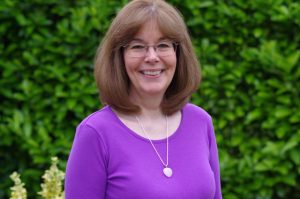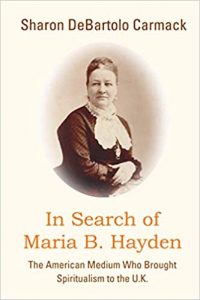Writing Women’s Lives
Writing Women’s Lives
 © 2021 Sharon DeBartolo Carmack, MFA, CG
© 2021 Sharon DeBartolo Carmack, MFA, CG
In early 2016, I started researching and writing a biography of Maria B. Hayden. What? You’ve never heard of her? She actually led a pretty interesting and noteworthy life. She was the American medium who introduced the religion of Spiritualism to the U.K. in 1852–53.
When I began, I did the usual Internet search and found some information about her, but practically nothing had documentation. So I consulted original records, and before I knew it, I wrote what ended up being a 600-page biography published four years later. (That page count includes extensive endnotes, genealogies, a bibliography, and other end matter.) As her biographer, it was my job to recreate her life story.
I kept in mind the words of biographer Carolyn C. Heilbrun, “Since no one’s life can be really known, since what is recorded or remembered very much depends on chance, as biographers or readers of biography, we all choose among the relics to form the life we want to envision for our subject.” And that’s what I had to do: choose among the relics, sort myth from truth, and try to write a historically accurate biography.
How do you do this when many women left so few accounts of themselves? If you find letters, diaries, or other sources she wrote, you’re lucky. I had none of these for Maria Hayden. I’m a Certified Genealogist, so I gathered data from historical records about her and her husband: censuses, vital records, newspapers, to name a few. I also researched more than thirty people for whom she did séances, looking for accounts they wrote about her. But to write her life story, I also needed to put her life into historical context.
Her Time and Place
Maria was born in 1824 in Falmouth Township, Hants County, Nova Scotia, Canada. I looked online and for published histories that told me about the time and place when she grew up there. She then followed two brothers to Boston, Massachusetts, around 1845 when she was twenty-one. Histories about Boston abound, so it was easy to recreate this setting.
But then by 1850, she lived with the man who would become her husband. They weren’t married. Was this typical or unusual? I turned to women’s social histories to learn about typical lifestyles for that time period. This lead me to research the “free love movement.”
Women’s Social History
Social histories tell about everyday people and their daily lives, as opposed to military histories that discuss wars, political histories that detail politics, or even traditional histories that focus on famous, national events and people. Social histories about women detail the typical experience and daily activities of ordinary women.
Begin by reading general women’s history books, which discuss all classes and races of women, such as Sara M. Evans’s Born for Liberty: A History of Women in America, Carol Hymowitz’s and Michaele Weissman’s A History of Women in America, or Carl N. Degler’s At Odds: Women and the Family in America from the Revolution to the Present.
There are also more specific social histories about women in a given time or place, such as Herbert Gutman’s The Black Family in Slavery and Freedom, 1750-1925, Glenda Riley’s Women and Indians on the Frontier, 1825-1915, or Carol Bleser’s In Joy and Sorrow: Women, Family, and Marriage in the Victorian South, 1830-1900. For Maria’s story, I read many books on women and the Spiritualist movement, including Anne Braude’s Radical Spirits: Spiritualism and Women’s Rights in Nineteenth-Century America.
When I learned about the free love movement, which reached intensity in the 1850s, I could speculate that Maria and her soon-to-be husband were proponents based on research about her husband and his liberal views. Free lovers opposed marriage laws that discriminated against women; some considered the crusade to be an opposition against marriage altogether. Many misunderstood the concepts of free love to mean promiscuity and infidelity. Free love meant no coercion in sexual relations.
Social History Topics
There are many topics to explore that may be pertinent to the women you want to write about.
Most women went through the same stages of life as women today: menstruation, childbirth, menopause. How these three stages were viewed and accepted depended on the time period and ethnic or socio-economic background of a woman. How women felt about their sexuality is attributable to society as well as cultural differences and historical era.
Through accounts left by Maria’s husband and her contemporaries, I learned that she had had a miscarriage on the ship to England or shortly upon arrival. She had also lost a child a few months before traveling overseas. This allowed me to speculate on the grief she must have felt and its impact on her mediumship. Times may change, but human emotions do not.
Since Maria and her husband dealt with the upper classes of English society, she and her husband would have had to learn about etiquette. I found on Google books, Samuel Roberts Wells’s How to Behave: A Pocket Manual of Etiquette and a Guide to Personal Habits (London: Walter Scott Publishing, 1857). This told me how they would have behaved, so that I could bring to life that aspect of their visit.
As you can see, you can write about women and bring them to life by putting pieces of their lives into historical context. Even though you can’t know in detail how the woman thought or behaved, you can speculate on these areas based on what you learn about the woman from your research and from social history research.
—
Sharon DeBartolo Carmack is a Certified Genealogist® with an MFA in Creative Nonfiction Writing. She is the author of twenty-five books, including You Can Write Your Family History; Tell It Short: A Guide to Writing Your Family History in Brief; and the biography, In Search of Maria B. Hayden: The American Medium Who Brought Spiritualism to the U.K. Her memoir, Midlife Medium: A Genealogist’s Quest to Converse with the Dead will be released in June 2022 by Köehler Books. She also teaches online classes in writing family history for Salt Lake Community College. She can be reached at www.SharonCarmack.com or www.TheGenealogyMedium.com.
IN SEARCH OF MARIA B. HAYDEN
 She was revered—and disdained. Maria B. Hayden of Boston and later New York City was the first American medium to bring the religion of Spiritualism to the U.K. in 1852–53. Through her séances in England and America, Maria convinced many of the elite and upper classes, as well as scientists and clergy, that there is life after death.
She was revered—and disdained. Maria B. Hayden of Boston and later New York City was the first American medium to bring the religion of Spiritualism to the U.K. in 1852–53. Through her séances in England and America, Maria convinced many of the elite and upper classes, as well as scientists and clergy, that there is life after death.
In a day when women were to be deferential to men, Maria forged ahead despite her critics, managing successful careers as a spirit medium, a healing medium, a clairvoyant physician, a psychometrist, and a medical doctor. In this definitive biography, Sharon DeBartolo Carmack rescues Maria from the mists of Spiritualist history, not only returning her to her rightful place as an important pioneer, but also providing an engaging portrait of this remarkable woman.
Carmack masterfully weaves together previously undiscovered archival, historical, and family documents with the social history of the Spiritualist movement to tell Maria’s life story. This biography also includes accounts of more than thirty of Maria’s seances, 130 illustrations, and appendixes with reproductions of her medical articles, a handwritten spirit communication from one of Maria’s private sittings, and fully documented Trenholm and Hayden genealogies.
BUY HERE
Category: On Writing
























